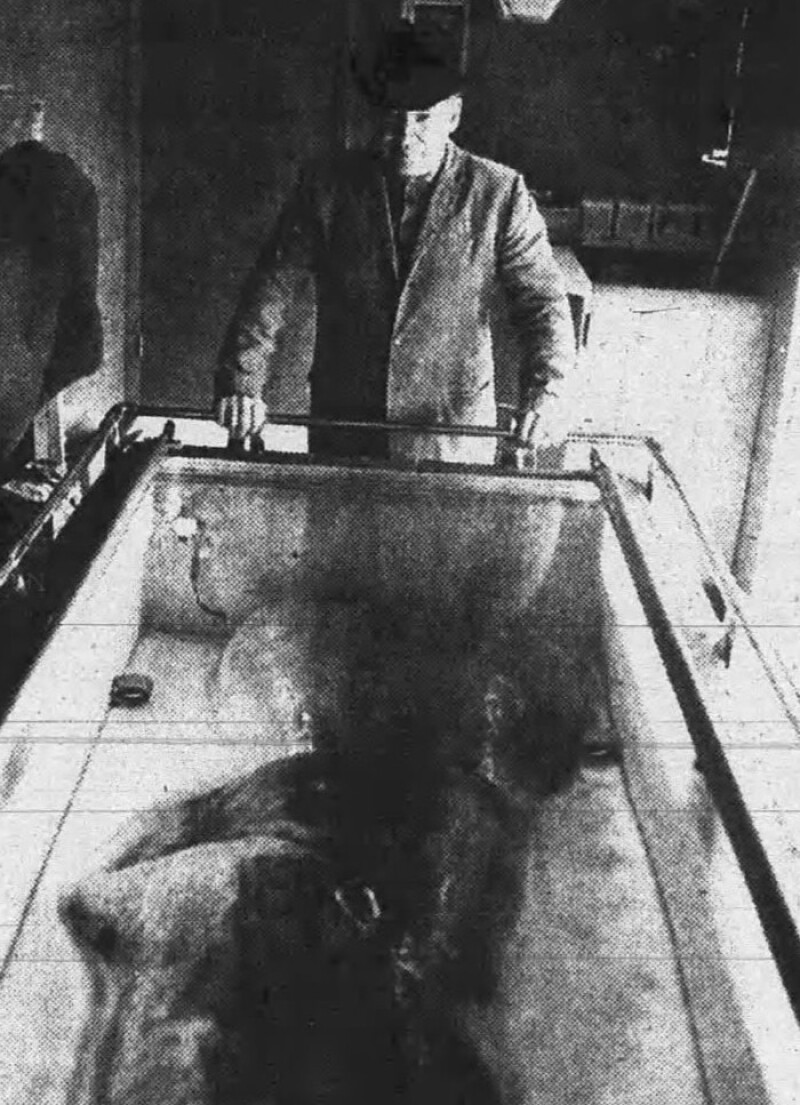Science
The Enigmatic Minnesota Iceman: Hoax or Reality?

In 1969, a bizarre attraction captured the imagination of fairgoers in Minnesota: the Minnesota Iceman. Displayed in a glass-covered casket, this peculiar exhibit featured a figure encased in ice, sparking questions about its origins and authenticity. Young Kim Rupprecht, who witnessed the spectacle at the Minnesota State Fair, described it as a sight that was both captivating and unsettling, with a partially visible eye and dark hair obscured by ice.
The individual behind this sideshow, Frank Hansen, a showman from Altura, Minnesota, transformed the Iceman into a national sensation. What began as a simple carnival attraction quickly evolved into a subject of scientific debate and intrigue. From the late 1960s to the early 1980s, Hansen toured the Iceman across various venues, including fairs and shopping malls, drawing crowds eager to determine whether it was a genuine relic or an elaborate hoax.
Scientific Scrutiny and Public Fascination
The Iceman gained significant attention when scientists and journalists, including the notable Ivan Sanderson, examined it closely. Sanderson, who wrote extensively on the Iceman for *Argosy* magazine, claimed that upon viewing the exhibit, he felt convinced of its authenticity. He noted the “appalling stench of rotting flesh” emanating from the display, suggesting it was not merely a crafted fake. Headlines in newspapers across the United States echoed this sentiment, with reports such as “Scientist believes carnival freak is unknown man” capturing widespread interest.
Despite the fervor, skepticism grew as the Smithsonian Institution sought to investigate the Iceman. After examining samples, they determined that the figure was a sophisticated fabrication made of latex and hair, ultimately dismissing it as a mere carnival exhibit. Yet, this debunking did little to diminish public curiosity. Hansen maintained the allure of the Iceman, often suggesting it was a replica of a more authentic specimen he kept hidden for safekeeping.
The Journey of the Iceman
Hansen’s dedication to the Iceman persisted throughout the years, with the exhibit appearing at numerous state fairs and exhibitions. In July 1969, border officials at Pembina, North Dakota, even halted the Iceman’s travel, demanding proof that it was not a real corpse. Following intervention from U.S. Senator Walter Mondale’s office, the Iceman was allowed to proceed, marking its continued prominence as a captivating exhibit.
By the late 1970s, however, Hansen seemed weary of the Iceman’s demands. He expressed a desire to remain home rather than continue the extensive touring. Despite this, he occasionally showcased the Iceman, including a notable display at a Rochester car dealership in 1983, although he insisted it was not there for commercial purposes.
In 2000, Hansen’s interest in the Iceman appeared to wane significantly. He stated, “That’s a done thing. I don’t want to even discuss him anymore.” Yet, as a showman, he couldn’t resist adding a final touch of mystery, claiming he knew as little about the Iceman as anyone else.
The Iceman’s saga took another turn in 2013 when it was listed for sale on eBay with an opening bid of $20,000. The listing included the original signage and freezer container, sparking intrigue online. Ultimately, the creature was purchased by the Museum of the Weird in Austin, Texas, where it remains on display, continuing to captivate visitors as a symbol of America’s fascination with the mysterious and the unknown.
The enduring legend of the Minnesota Iceman serves as a reminder of humanity’s desire to explore the extraordinary, even when faced with the possibility of deception. Its journey from a sideshow attraction to a subject of scientific inquiry and public intrigue illustrates the complexities surrounding belief and skepticism in the pursuit of truth. Visitors to the museum can still witness the frozen coffin, now under the grand sign proclaiming, “It’s the World Famous Creature in Ice.”
-

 Business1 week ago
Business1 week agoIconic Sand Dollar Social Club Listed for $3 Million in Folly Beach
-

 Politics1 week ago
Politics1 week agoAfghan Refugee Detained by ICE After Asylum Hearing in New York
-

 Health1 week ago
Health1 week agoPeptilogics Secures $78 Million to Combat Prosthetic Joint Infections
-

 Science1 week ago
Science1 week agoResearchers Achieve Fastest Genome Sequencing in Under Four Hours
-

 Health1 week ago
Health1 week agoResearcher Uncovers Zika Virus Pathway to Placenta Using Nanotubes
-

 Lifestyle1 week ago
Lifestyle1 week agoJump for Good: San Clemente Pier Fundraiser Allows Legal Leaps
-

 World1 week ago
World1 week agoUS Passport Ranks Drop Out of Top 10 for First Time Ever
-

 Business1 week ago
Business1 week agoSan Jose High-Rise Faces Foreclosure Over $182.5 Million Loan
-

 Entertainment1 week ago
Entertainment1 week agoJennifer Lopez Addresses A-Rod Split in Candid Interview
-

 Top Stories6 days ago
Top Stories6 days agoChicago Symphony Orchestra Dazzles with Berlioz Under Mäkelä
-

 World1 week ago
World1 week agoRegional Pilots’ Salaries Surge to Six Figures in 2025
-

 Science1 week ago
Science1 week agoMars Observed: Detailed Imaging Reveals Dust Avalanche Dynamics









